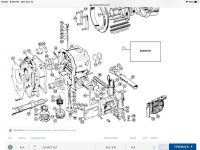Healey Nut
Luke Skywalker
Offline
Has the OD ever been rebuilt ?
if not then chances are that’s where this is heading
your Accumulator piston rings are probably worn out And the OD is probably full of metallic sludge .
pull the OD and rebuild it , they are not complicated , take your time lay out the parts methodically on the bench .take notes , pictures etc .
clean everything scrupulously clean . Replace anything that looks worn , piston rings , seals , springs ,ball bearings , gaskets etc .
the actual rebuilding of the OD is a 5/6hr leisurely job once it’s on the bench . Including lunch .
.
a good set of hand tools and something to wash parts in solvent and a compressed air source is all you need .
use the compressed air to blow out all the oil galleries etc to make sure nothing is blocked up .
if not then chances are that’s where this is heading
your Accumulator piston rings are probably worn out And the OD is probably full of metallic sludge .
pull the OD and rebuild it , they are not complicated , take your time lay out the parts methodically on the bench .take notes , pictures etc .
clean everything scrupulously clean . Replace anything that looks worn , piston rings , seals , springs ,ball bearings , gaskets etc .
the actual rebuilding of the OD is a 5/6hr leisurely job once it’s on the bench . Including lunch
 .
.a good set of hand tools and something to wash parts in solvent and a compressed air source is all you need .
use the compressed air to blow out all the oil galleries etc to make sure nothing is blocked up .

 Hi Guest!
Hi Guest!

 smilie in place of the real @
smilie in place of the real @
 Pretty Please - add it to our Events forum(s) and add to the calendar! >>
Pretty Please - add it to our Events forum(s) and add to the calendar! >> 

